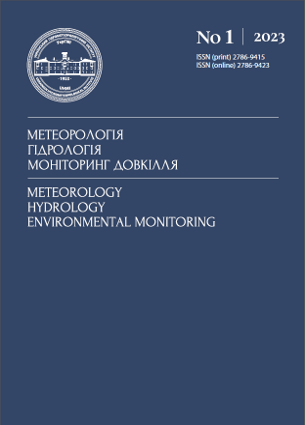LOGICAL-APRIORI ANALYSIS IN HYDROGEOLOGICAL RESEARCH
Ukrainian Hydrometeorological Institute of the State Emergency Service of Ukraine and the National Academy of Sciences of Ukraine, Kyiv, Ukraine
https://orcid.org/0000-0002-5791-5354
Abstract
References
1. Bugai D.O. etc. Study of the migration of radionuclides at the experimental site-polygon in the Rudy lis PTLRV. Part 2: Migration of radionuclides in the geological environment. Chernobyl of science Bulletin, 2007. 2 (30). 16–33
2. Kamzist, J.S., Shevchenko, O.L. Hydrogeology of Ukraine. Kyiv, 2009. 614
3. Kovalevsky V.S. Conditions of formation and forecasts of the natural regime of groundwater. Moscow: Nedra, 1973. 152
4. Konoplyantsev A.A. Issues of studying and forecasting the regime of groundwater. Moscow, 1970. Them. issue, 25. 34-58
5. Saprykin V.Yu., Bugai D.O., Skalskyi O.S., Dzepo S.P., Van Meer N., Kubko Y.I., Simonucci K. Regime of infiltration of groundwater in the area of the Chernobyl “Red Forest”. Collection of scientific works of the Institute of Geological Sciences of the National Academy of Sciences of Ukraine. 2011. 4. 141-151
6. Sitnikov A.B., Golovchenko Yu.G., Tkachenko K.D. Hydrogeological station 'Feofania': long-term research and results. NAS of Ukraine. Institute of Geol. Sci. Кyiv, 2003. 200
7. Shevchenko O.L. Unification of principles and units of hydrogeological zoning of Ukraine. Collection of scientific works of the Ukrainian State Geological Survey Institute, 2008. 2. 37-45
8. Shevchenko O.L., Kozytskyi O.M., Nasedkin I.Yu., Ryabtseva G.P., Bublyas V.M., Ivanushkina N.I., Osadcha N.M., Syzonenko V.P. (2011). Patterns of migration of man-made radionuclides on reclamation systems of the Chernobyl Exclusion Zone (based on research results from 1986-2004)/ ed. in chief V.A. Stashuk, Kherson: Ukraine. 415
9. Shevchenko O.L., Nasedkin I.Yu. Water-radiation-balance studies for the justification of water protection measures in the Chernobyl Exclusion Zone. Reclamation and water management. 89. 2003. 157-170
10. Shevchenko A.L., Nasedkin I.Yu. Natural-anthropogenic features of the formation of water exchange and the spread of radioactive substances in reclamation systems of the humid zone // Water exchange in hydrogeological structures and the Chernobyl disaster. Part 1. Kyiv, NAS of Ukraine, 2001. 162-232
11. Shevchenko О.L. Radiohydrogeology of drainage landscapes of the Ukrainian Polissia (on the example of the Chernobyl exclusion zone). dissertation for obtaining sciences. degree of Doctor of Geol. Sciences: specialty 04.00.06 'Hydrogeology'. Kyiv: Institute of Geol. of Sciences of the National Academy of Sciences of Ukraine, 2016. 382 p.
12. Chouaib W., Alila Y., Caldwell P.V. Implications of a Priori Parameters on Calibration in Conditions of Varying Terrain Characteristics: Case Study of the SAC-SMA Model in Eastern United States. Hydrology. 2021; 8(2): 78. https://doi.org/10.3390/hydrology8020078
13. Duan Q.; Schaake J.; Koren V.I. A Priori estimation of land surface model parameters. Water Science and Application; American Geophysical Union: Washington, DC, USA, 2001. 3. 77–94.
14. Hrachowitz M., Savenije H., Blöschl G., McDonnell J., Sivapalan M., Pomeroy J., Arheimer B., Blume T., Clark M., Ehret U. et al. A decade of Predictions in Ungauged Basins (PUB): A review. Hydrol. Sci. J. 2013, 58, 1198–1255.
15. Koren V., Smith M., Duan Q. Use of a priori parameter estimates in the derivation of spatially consistent parameter sets of rainfall-runoff models. In Calibration of Watershed Models; American Geophysical Union: Washington, DC, USA, 2003. 239–254.
16. Shevchenko A. 2002. Distribution and Migration of Radionuclides in Meliorated Areas // Chernobyl disaster and groundwater / Editor V. Shestopalov. Publisher Lisse/Abingdon/Exton(pa)/Tokyo: A.A. Balkema. 133-186.
17. Tiwari Mukesh K., Adamowski J. (2013). Urban water demand forecasting and uncertainty assessment using ensemble wavelet-Bootstrap-Neural network models. Water resources research, 49. 6486–6507.
18. Yao C.; Li Z.; Yu Z.; Zhang K. A priori parameter estimates for a distributed, grid based Xinanjiang model using geographically based information. J. Hydrol. 2012. 468–469. 47–62.
19. Yokoo Y.; Kazama S.; Sawamoto M.; Nishimura H. Regionalization of lumped water balance model parameters based on multiple regression. J. Hydrol. 2001. 246. 209–222.

